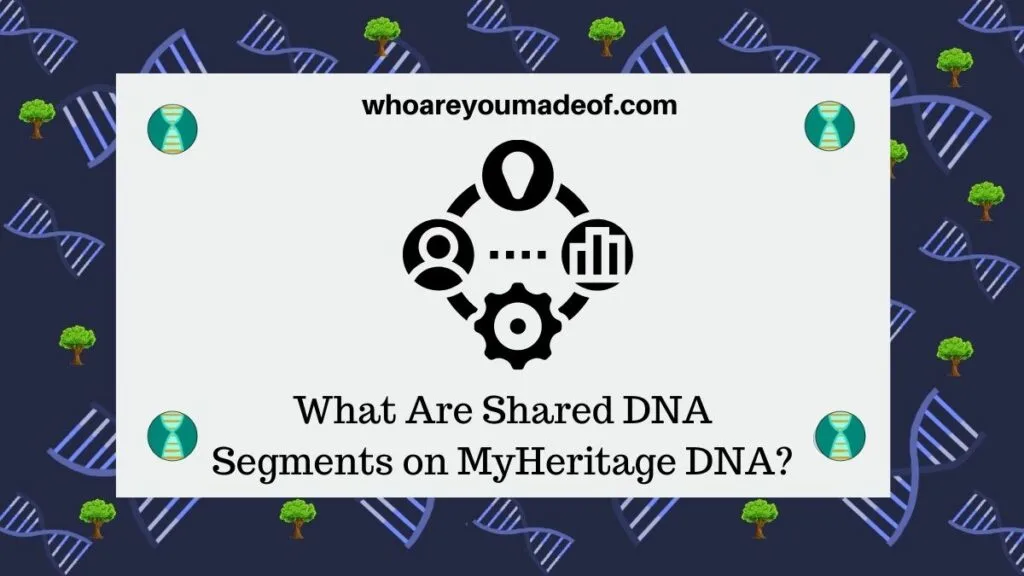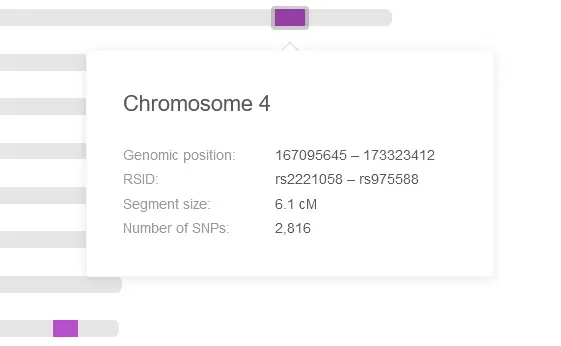Do you want to know more about shared DNA segments on MyHeritage? In this post, learn exactly what those small, purple lines stand for, and how to use them in your family tree research.
You will also discover:
- What the numbers on the lines with the purple segments stand for
- How to understand the information that appears when you hover over the segment
- How to use shared DNA segments on My Heritage to find out which ancestor you share with your genetic relatives
- Whether the purple lines represent characteristics or observable traits

MyHeritage DNA is one of my favorite sites to use to explore my DNA matches. Most people will have at least several hundred, if not several thousand, genetic relatives on their match list.
We are able to see an incredible amount of information about the DNA that we share with our matches on MyHeritage. One of the most helpful tools to explore our connection with a match is the chromosome browser, which is accessible directly on the match page that displays your genetic connection to a relative, or through the Chromosome Browser Tool.
What does Shared DNA Segment mean on My Heritage?
A Shared DNA Segment on MyHeritage means that you and your DNA match have identical DNA on at least one copy of your chromosome at the location indicated on the chromosome browser. We share at least one identical segment with all of our DNA matches, but can have multiple shared DNA segments with the same relative.
What do the purple shared segments represent on MyHeritage?
The purple segments represent the identical segments of DNA that are identical to your DNA match. Grey portions of your chromosome shown on the chromosome browser represent portions of your DNA that do not match your relative.
Are all Shared DNA Segments "real"?
Those purple segments that are longer in length are more likely to have been inherited by both you and your DNA match from a shared ancestor. It is possible to share multiple DNA segments with a match inherited from the same ancestor, or segments that were inherited from different shared ancestors.
It is also important to understand that it is possible to have small "false" shared DNA segments, even with people who we know we are related to.
We can use the number of centimorgans shared on a segment and the number of SNPs to determine how likely it is that a purple shared segment is a legitimate shared segment inherited from a shared ancestor. There are few definite rules to use for evaluating the validity of shared segments, but there are some general guidelines.
For example, segments smaller than 6 cMs are very likely to be false. However, segments longer than 10 cMs are more likely to be "real", identical-by-descent segments, meaning that they are identical because they were inherited from a shared ancestor.
The second criteria used to evaluate shared DNA segments are the number of SNPs (single nucleotide polymorphisms). These are locations in our chromosomes that are compared to our DNA matches; the more positions that are identical, the longer the segment and the more likely it is that the segment is real.
We hope to see at least about 700 SNPs for a legitimate shared segment. However, more is always better, which means that a 6.6 cM segment with 2000 identical SNPs is more likely to be identical-by-descent than if the segment had only 600 SNPs.
This information is available directly on your MyHeritage DNA match profile page, and I'll discuss it in more detail in further on in this article.
Do shared DNA segments represent characteristics or observable traits
Shared DNA segments only represent identical DNA that was likely passed down from a shared ancestor. The way that we look, our personality traits, and the way our genes affect our health and physical development is a complicated process determined by the way that genes located on both copies of our chromosome at any given location respond to each other and external environmental factors.
We do share DNA segments with siblings that are identical on both copies of our chromosomes, which is why we tend to have more observable characteristics in common with our siblings than with other relatives with which we share smaller segments only identical on one copy of the chromosome.
What do the numbers on the Chromosome Browser stand for on MyHeritage?
If you hover over a purple segment, or Shared DNA Segment, on My Heritage, you will see a small box appear that shows some big numbers. Once you know the basics of these terms, you will be able to make sense of the details.
The information that you see will appear something like this:

Below, find what these terms and abbreviations mean:
- Genomic position: exact location on the chromosome of the shared DNA segment
- RSID: Stands for "RS numbers", also known as "Reference SNP cluster ID", not commonly used for genealogy
- Segment size: The length of the identical DNA segment, measured in centimorgans
- Number of SNPs: The number of identical single nucleotide polymorphisms, or locations that are identical
We see that these two individuals share a small, 6.1 centimorgan DNA segment located on Chromosome 4. The exact position of the shared segment on the chromosome begins at 167095645 and ends at 173323412, and has 2816 SNPs, which means that this segment has a good possibility of having inherited from an actual shared ancestor, even though it is small.
Does a long shared DNA segment on MyHeritage mean a close recent ancestor?
As I mentioned previously, the longer the shared DNA segment, the higher the probability that the segment was inherited from a shared ancestor. In addition, we also know that very long segments are more likely to have been inherited from a more recent ancestor.
We share very long DNA segments with our parents, and these segments are broken up when they are passed down to our children. Over the course of just a few generations, a segment can be reduced in size from over 200 cM to less than 50.
As an example, I pulled up results for my grandmother, my father, myself and my daughter. Below are the longest segments shared between my grandmother and her descendants:
- Longest segment shared between my grandmother to her son (my father): 282 cMs
- Longest segment shared between my grandmother and granddaughter (me): 184 cMs
- Longest segment shared between my grandmother and her great-granddaughter (my daughter): 101 cMs
You can see clearly how the size of the largest segment gets smaller as the distance between the ancestor, who in this case is my daughter's great-grandmother, becomes greater.
Someday, if my daughter has children, they, too, will inherit some DNA that was originally passed to me from my grandmother. However, the segments will be smaller than 100 cMs.
The DNA segments that my daughter shares with her great-grandmother range in size between 9-101 cMs. The smaller of these segments are less likely to be passed down to the next generation, and the larger segments will likely be broken up into smaller ones.
How can the shared DNA segment help you determine your relationship to your DNA match?
As you now know, the DNA segments that you share with your matches were inherited from your shared common ancestor. It is possible to collect and use data from shared DNA segments in order to create a "map" of your chromosomes.
This chromosome mapping strategy can help you figure out exactly which DNA segments were passed down from a particular ancestor. Once you have mapped a significant portion of your DNA, you will be able to compare segments that you share with your chromosome "map" to identify exactly which line of your tree you share, or even the exact ancestor you share in common.
The easiest tool for chromosome mapping, which happens to be my favorite, is DNA Painter. It's free to use a basic account, and you can read the following article to learn the basics of how to use it:
Conclusion
I hope that this post has helped you understand more about shared segments on MyHeritage, how to use them to learn more about your family tree, and what all of those numbers really mean. These shared segments can be traced directly back to our ancestors, so they are very valuable in discovering more about our family's story.
If you have any questions about something that you read in this post, or if you would like to share something interesting that you have observed on your MyHeritage DNA match list, please join us in the discussion below.
Thanks for reading today!
